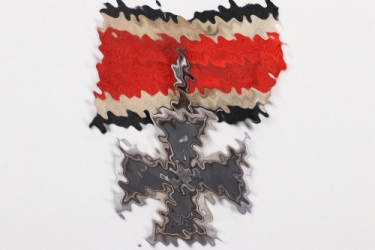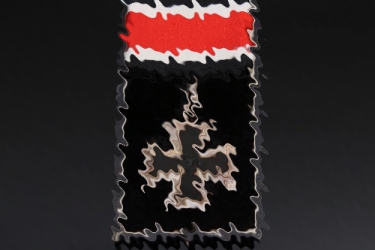Ritterkreuz des Eisernen Kreuzes
Militaria Preisdatenbank
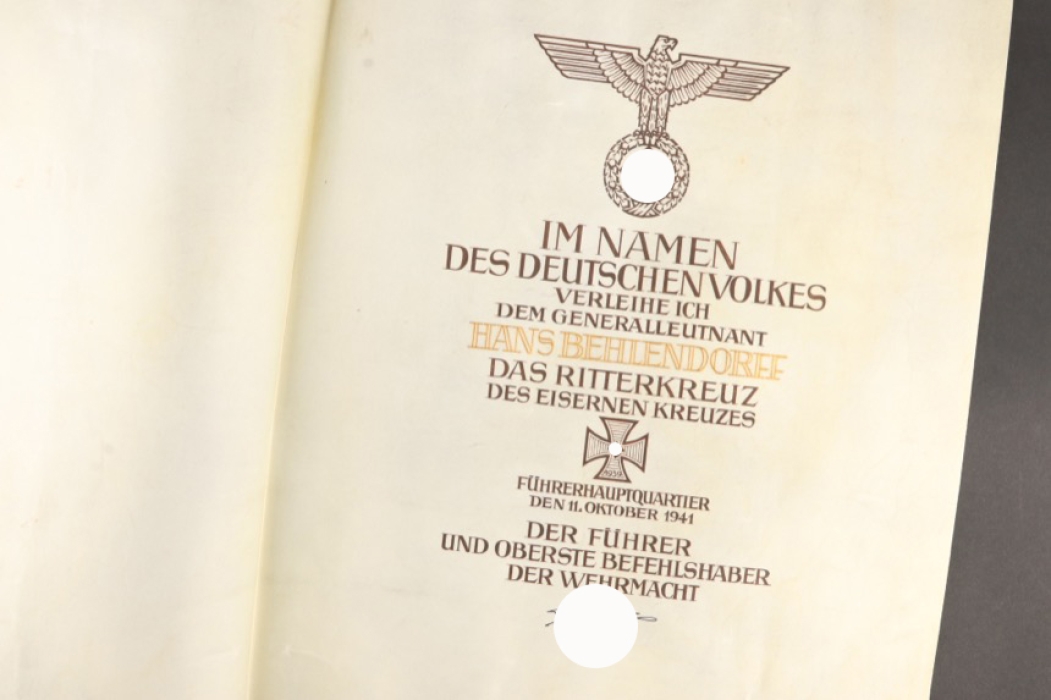
Generalleutnant Hans Behlendorff - Urkunde zum Ritterkreuz des Eisernen Kreuzes
MILITARIA PREISDATENBANK
Wie kann ich Verkaufspreise sehen?
Melden Sie sich noch heute unter www.ratisbons.com/de/militaria-preisdatenbank für unsere MILITARIA PREISDATENBANK an! Bei Abschluss eines jährlichen Abonnements für nur 75€ sparen Sie 25%.
Ihr Zugang zu allen Verkaufspreisen, Bildern und Beschreibungen wird umgehend nach Abschluss Ihres Abonnements freigeschaltet.
Wir kaufen Einzelstücke und ganze Sammlungen und beraten Sie auch gerne telefonisch: 08541 9053699
-
Bezahlung
-
WIE KANN ICH FÜR MEINE BESTELLUNG BEZAHLEN?
AUKTIONAlle erfolgreichen Gebote werden automatisch zu einer einzigen Bestellung zusammengefasst. Für diese können Sie uns nach Auktionsende in Ihrem persönlichen Kundenkonto Ihre bevorzugte Bezahl- und Versandart oder eine alternative Lieferadresse mitteilen.
Wenn wir diese freiwilligen Angaben nicht von Ihnen erhalten melden wir uns automatisch im Laufe des Montags nach Auktionsende mit einer Zahlungsanweisung per Email. Basierend auf Erfahrungswerten schlagen wir Ihnen die bequemste Bezahlmehtode und die günstigste Versandart vor. Sie möchten Ihre Bezahl- und Versandart ändern oder eine alternative Lieferadresse angeben? Kein Problem! Besuchen Sie Kundenkonto/BESTELLUNGEN oder kontaktieren Sie uns per Email.
BESTELLUNGEN IM ONLINESHOPWählen Sie während der Bestellung Ihre bevorzugte Bezahl- und Versandart und schicken Sie diese ab. Sie erhalten Ihre Zahlungsanweisung spätestens am darauffolgenden Tag per Email. Die Zahlungsfrist beträgt sieben Tage. Sie planen eine Bestellung per Ratenzahlung zu begleichen? Bitte sprechen Sie uns gerne vor Ihrer Bestellung darauf an.
Für mehr Informationen zu Bezahlung und Versand, besuchen Sie unsere Häufigen Fragen.
WIR AKZEPTIEREN FOLGENDE BEZAHLARTEN
-
-
Versand
-
IHRE BESTELLUNG IN DEN BESTEN HÄNDEN
VERPACKUNG & SENDUNGSVERFOLGUNGNach Zahlungseingang versenden wir Ihre Bestellung für gewöhnlich am darauffolgenden Werktag. Wir bestätigen den Eingang Ihrer Zahlung per Email und informieren Sie zur Versandvorbereitung. Nach Abholung der Sendung durch unsere Versanddienstleister teilen wir Ihnen die Sendungsnummer per Email mit. Den Status Ihrer Sendung können Sie auch jederzeit unter Kundenkonto/BESTELLUNGEN einsehen. Ihre Rechnung geht Ihnen automatisch am Tag des Versands zu.
VERSAND ZU EINER ALTERNATIVEN ADRESSEBevorzugen Sie für eine Bestellung einen Versand zu Ihrer Arbeitsstelle? Sie sind im Urlaub und wünschen den Versand zu einer Packstation oder einem Freund? Kein Problem! Diese Änderungen können Sie jederzeit unter Kundenkonto/BESTELLUNGEN vornehmen. Alternativ können Sie natürlich jederzeit auch per Email informieren.
UNSERE PARTNER FÜR DEN VERSAND
-
-
Garantie
-
 GARANTIE!
GARANTIE!Alle angebotenen Artikel werden von unseren Experten akribisch auf deren Echtheit geprüft und detailiert beschrieben. Wir bieten ausschließen zeitgenössiche Originale an. Etwa 15% aller Kundeneinlieferungen ensprechen unseren Anforderungen nicht und werden retourniert.
Gekauft wie gesehen? Nicht bei uns. Im Gegensatz zu traditionellen Auktionshäusern bieten wir volles Rückgaberecht of Originalität an. Sollten Sie mit Ihrer Bestellung nicht zufrieden sein, können Sie die Bestellung innerhalb 14 Tagen widerrufen. Bitte kontaktieren Sie uns vor dem Rückversand. Für mehr Einzelheiten besuchen Sie bitte unsere häufigen Fragen.
In eigener Sache: Bieten Sie nur auf Lose, die Sie auch erwerben möchten. Bitte vermeiden Sie Gebote nach Auktionende zu stornieren. Sollten Sie ein fehlerhaftes Gebot abgegeben haben, informieren Sie uns bitte umgehend. Wir löschen Ihre Gebote gerne bis 24 Stunden vor Ende der Auktion.
-
Land Deutsches Reich 1918 - 1945
Maße 43.8 x 35.5 cm
Gewicht
 US Los 62-0002
US Los 62-0002EAN 3000000016114
 US Los 62-0002
US Los 62-0002Epoche 1918 — 1945
Land Deutsches Reich 1918 - 1945
Land Deutsches Reich 1918 - 1945
 US Los 62-0002
US Los 62-0002Deutsches Reich 1918 - 1945
Ritterkreuz des Eisernen Kreuzes
Beschreibung
Generalleutnant Hans Behlendorff (August 13, 1889 – March 16, 1961)
Generalleutnant Hans Behlendorff joined the Imperial Army on September 25, 1908, as a cadet. He came to the 1st Brandenburg Field Artillery Regiment "General Feldzeugmeister" No. 3. In this he was promoted to lieutenant on March 22, 1910, after attending military school. The patent was dated March 22, 1908. With this he went to the front at the beginning of World War I. There he was promoted to Oberleutnant on February 25, 1915. As such, he was employed as battery commander from the summer of 1915. By that time, he had already been awarded both Iron Crosses. In the summer of 1916, he was wounded and only returned to the front in the autumn of 1916. From the spring of 1917 he was employed as an adjutant on a staff. There he was promoted to captain on May 20, 1917. During the First World War he was awarded several other orders in addition to the Knight's Cross of the Royal Prussian House Order of Hohenzollern with Swords. After the war he was accepted into the Reichswehr. He was assigned to the 3rd Reichswehr Artillery Regiment in the transitional army in spring 1920. When the 100,000-strong Reichswehr Army was formed, he was then assigned to the 3rd (Prussian) Artillery Regiment. In this he was initially used in a departmental staff. In 1922 he was appointed chief of the 11th (riding) battery of the 3rd (Prussian) artillery regiment in Potsdam. In the spring of 1928, he was transferred to the staff of the IV (riding) department of the 3rd (Prussian) artillery regiment in Potsdam. On February 1, 1929, he was promoted to Major. The rank seniority was set to February 1, 1928. In early 1930 he was transferred to the Reichswehr Ministry in Berlin. There he was employed in Army Personnel Department 2 (P2) by the Army Personnel Office (PA). On April 1, 1932, he was then transferred to Army Personnel Department 1 (P1) from the Army Personnel Office (PA) in the Reichswehr Ministry. There he was promoted to lieutenant colonel on October 1, 1932. In 1934 he was appointed head of the new Army Personnel Department 4 (P4). As such, he was promoted to Colonel in April 1934. During the major shift in personnel to the Blomberg-Fritsch affair, he was appointed Artillery Commander 31 (Arko 31) on February 4, 1938. As such, he was promoted to Major General on March 1, 1938. In the summer of 1939, he was appointed commander of the 34th Infantry Division. At the beginning of World War II, he and his division took up positions in the west. On February 1, 1940, he was promoted to Generalleutnant. Already at the beginning of the western campaign he was awarded both clasps to his Iron Crosses. On the first day of the campaign, he was also badly wounded and had to give up his command for almost half a year. On November 1, 1940, he took it over again. At the beginning of the eastern campaign, he led the 34th Infantry Division in the attack on Central Russia. On October 11, 1941, he was awarded the Knight's Cross of the Iron Cross. At the beginning of December 1941, he relinquished his command. He has now been transferred to the Führerreserve. In mid-December 1941 he was appointed to the leadership of the Higher Command z.b.V. LX commissioned in northern France. On December 17, 1941, he was promoted to General der Artillerie. The rank seniority was dated October 1, 1941. As such, he then became the commander of the Higher Command z.b.V. LX appointed. By renaming the staff, he became Commanding General of LXXXIV Army Corps at the end of May 1942. On April 1, 1943, he resigned his command and was transferred to the Führerreserve. On December 31, 1944, he was finally dismissed from active service in the Wehrmacht. (From Lexikon der Wehrmacht)
Knights Cross of the Iron Cross formal award document issued to Generalleutnant Hans Behlendorff on parchment with an integral blank front leaf, Führerhauptquartier, October 11, 1941. The ornately lettered document is executed in India ink and gold with a hand-inked signature of Adolf Hitler at the bottom. The parchment is just the slightest bit wavy, as is very common in such documents, but otherwise fine condition. Award documents for the Knight’s Cross are rare, even though Hitler granted over 7,000 of them. A severe backlog soon developed and, in the end, very few recipients of the award ever received their large formal award documents.
The document is part of a veteran bring-back that we proudly offer here for the very first time. The GI opted to bring 9 single formal documents in one red presentation leather folder (Mappe) which will be auctioned with Ratisbon’s through a couple of auctions.
Zustand
1-
Verkäufer
History Trader Inc., 521 Thorn Street #165, Sewickly, PA 15143-0165, USA
NAME
Ritterkreuz des Eisernen Kreuzes
DATUM DER STIFTUNG
1. September 1939 als dritte und neue Stufe des wiederhergestellten Ordens vom Eisernen Kreuz
AUSZEICHNUNGSKRITERIEN
Das Ritterkreuz des Eisernen Kreuzes wurde für besondere Tapferkeit im Angesicht des Feindes und für heraus- ragende Verdienste um die Truppenführung verliehen. Die Verleihung des Ritterkreuzes erforderte die vorherige Vergabe der beiden niedrigeren Stufen. Das Ritterkreuz wurde allein vom Führer auf Vorschlag der Einheit des Soldaten verliehen und vom Heerespersonalamt ausgestellt. Die Ritterkreuze wurden in der Ordenskanzlei in Berlin aufbewahrt, um nach Genehmigung dem Beliehenen zugeschickt zu werden. Vor Ende April 1945 wurden auf keiner Ebene der Wehrmacht Ritterkreuze gelagert.
HERSTELLER
Das Ritterkreuz des Eisernen Kreuzes wurde von sieben Herstellern gefertigt, Varianten innerhalb den einzel- nen Firmen nicht berücksichtigt. Die Ritterkreuze findet man entweder ungestempelt (frühe Juncker und 3/4 Ring Kreuz), mit Silbergehaltsstempel, mit einer LDO-Nummer (L/12 und L/52) und später mit der Präsidialkanzlei- Nummer des Herstellers (2, 20, 65 und 4). Privatverkauf war ab Oktober 1941 verboten.
VERLEIHUNGSZAHLEN
Genaue Zahlen sind nicht bekannt, aber die Schätzungen liegen bei 7.200 und ein paar hundert mehr auf Laager bei der Präsidialkaanzlei.
AUSZEICHNUNGSUNTERLAGEN
Der Beliehene erhielt eine vorläufige Urkunde im Format A5, ausgestellt im Namen des Führers von den zustän- digen Personalämtern der drei Wehrmachtsteile. Die formellen Urkunden (Große Mappe) wurden später aus- gestellt und sind aufgrund des großen Herstellungsrückstandes nur mit Datum Ende 1942/Anfang 1943 zu finden.
TRAGEMETHODE
Das Ritterkreuz wurde mit dem rot/weiß/schwarzen Band als Halsorden getragen. Das Ritterkrreuz wurde im schwarzem Etui und beiliegendem Band verliehen.




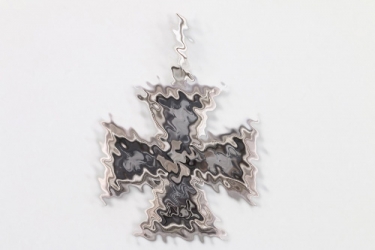
.jpg)



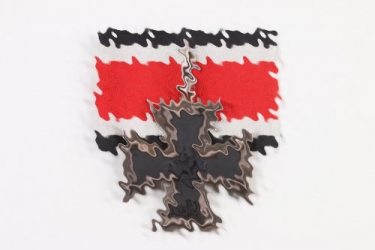
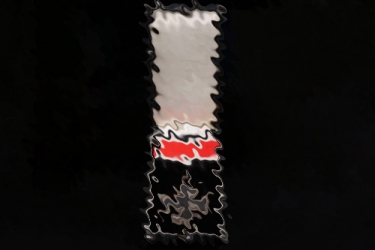


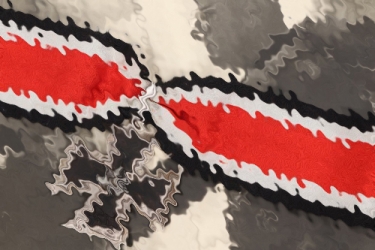
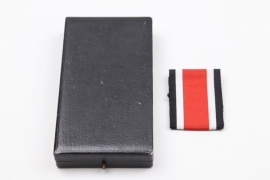
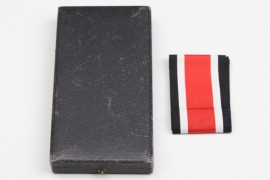
.jpg)

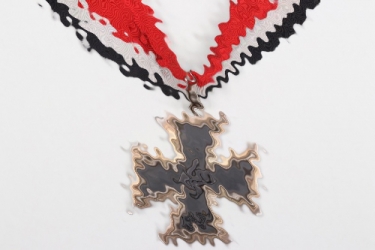

.jpg)


